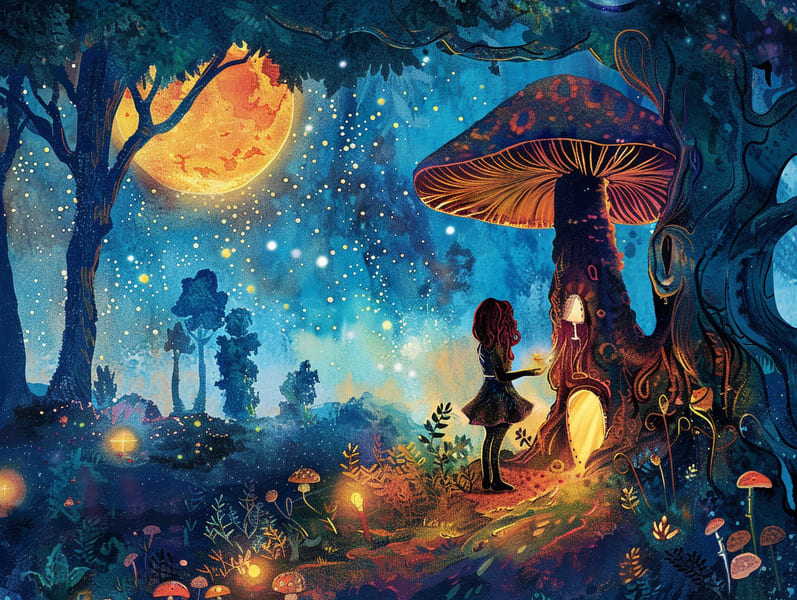
Fairy tales have historical significance. These stories have been narrated from one generation to the next ages before they were ever recorded. They came from a variety of cultures, including Middle Eastern traditions. They were initially narrated among adults, often carrying themes and messages relevant to the societal norms and beliefs of the time.
The Brothers Grimm, Jacob and Wilhelm (the Grimm brothers), were among the first to collect and release many of these beloved fairy tales. Their collection, "Grimm's Fables," included narratives like "Cinder Maid," "The Story of Hansel and Gretel," and "Schneewittchen," which have since become hallmarks in the world of famous fairy tales. Similarly, Andersen's enchanting fairy tales, such as "The Mermaid," and "The Ugly Duckling," have won hearts worldwide, ensuring their place in the pantheon of beloved fairy tales.
Though they are old, these tales remain as important as ever, especially as kids' bedtime tales. These magical stories are now available in many formats, including beautifully illustrated books, enchanting animations, and digital storybooks.
Their enduring popularity can be linked to several enchanting factors:
Crucial Morals: Traditional fairy tales often offer important moral lessons. Fairy tales like "The Wolf and the Liar" teach the value of sincerity, while "The Tale of the Tortoise and the Hare" show the qualities of determination and meekness. These tales offer children clear distinctions between ethical and unethical, building their moral compass in a tender yet impactful way.
Warmth and Understanding: Ancient fairy tales frequently showcase figures facing struggles and tests, provoking children to identify with their struggles and root for their triumphs. For instance, "Beauty's Beast" reveals the benefit of looking past the exterior to see the true character of a character, cultivating sympathy and awareness.
Cultural Appreciation: Many ancient fairy tales are deeply ingrained in the cultural contexts from which they grew. Engaging with these narratives can provide fascinating glimpses into different backgrounds, promoting a sense of cultural awareness and recognition.
Imagination and Innovation: The fanciful elements in classic fairy tales—mythical entities—spark children’s visions and dreams. These fairy tales bring readers to extraordinary realms, awakening imaginative ideas and a sense of fascination that continues a lifetime.
Ancient fairy tales are not only fascinating but also instructive. They function as magical tools in cultivating various cognitive and affective skills in little ones. When fairy tales are spoken, they advance linguistic abilities by showing new lexicon and intricate sentence structures. This practice also promotes listening abilities and focus, as children listen intently, anticipating to see what happens next.
Furthermore, debating the themes and characters of classic fairy tales can strengthen evaluative skills and cognitive skills. Young readers learn to find patterns, foresee events, and make sense of cause and effect. These talks also boost little ones voice their thoughts and feelings, fostering their emotional intelligence.
In today’s electronic age, the presence of digital storybooks has made these stories more obtainable than ever. Web platforms and software give comprehensive collections of popular fairy tales that can be looked at or played anytime, anywhere. Fairy tales told out loud are particularly favored, providing an engaging way for kids to relish these alluring stories. Read-aloud stories and narrated videos move characters and settings to life, often paired with whimsical melodies and musical scores that elevate the story journey.
The timeless appeal of classic fairy tales lies in their ability to adjust to modern society while maintaining their central messages. Contemporary adaptations of these fairy tales often highlight more inclusive characters and modern settings, making them accessible to today’s audience. However, the classic fairy tales underlying themes of fortitude, benevolence, and equity remain unchanged, continuing to reach audiences of all ages.
Fairy tales also offer a sense of reassurance and predictability. They confer upon a orderly narrative with a unmistakable beginning, middle, and end, often finishing with the finalization of conflicts and the triumph of righteousness over wickedness. This assuredness can be solacing for children, gifting a sense of sturdiness in an always shifting world.
Ancient fairy tales continue to entrance and teach new generations, maintaining their charm and importance in modern society. As bedtime stories for kids, they furnish a perfect blend of enchantment and education, advancing moral values, empathy, and creativity. The abundance of internet fairy tales and the favor of fairy tales read aloud make sure that these old fairy tales remain obtainable to new generations.
By safeguarding and sharing these narratives, we continue to value the rich tapestry of fables and cultural heritage. Whether you are enjoying a colorful picture book, seeing a online library, or listening to an audiobook, the beauty of famous fairy tales is always within reach. These narratives highlight of the continued power of storytelling and its ability to unite us across epochs and places.
If you are discovering a gorgeously illustrated book, seeing a virtual library, or hearing an audio story, the spell of Grimm's fairy tales is always within reach.
These fairy tales demonstrate of the immortal influence of narratives and its ability to gather us across epochs and places, creating a bond that delights and instructs alike.